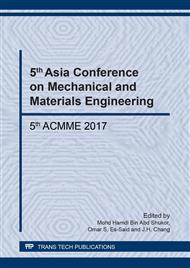p.199
p.207
p.213
p.219
p.225
p.231
p.237
p.243
p.249
Investigation of the Influences of Reaction Temperature and Time on the Chemical Reduction of Graphene Oxide by Conventional Method Using Vitamin C as a Reducing Agent
Abstract:
The aim of this work is to investigate the synthesis of reduced graphene oxide (rGO) aqueous suspension by a conventional heating method using vitamin C as a reducing agent. The influences of reaction temperatures (70, 90 and 100 °C) and heating times (30, 45 and 60 min) on the chemical reduction of graphene oxide (GO) were studied. Then, the obtained rGO samples were characterized by FT-IR, Raman and UV-Vis spectroscopy. The FT-IR and Raman results showed that the reduction degree of GO to rGO was increased with the rising of the reaction temperature and time. Moreover, the UV-Vis spectra demonstrated that the absorption band at around 230 nm (π-π*) of pristine GO had shift to the longer wavelength upon the chemical reduction, indicating that GO is reduced to rGO. The optimal condition of the chemical reduction of GO to achievable rGO was the temperature of 90 °C with the 45 min of heating time. This condition yielded the rGO black aqueous suspension with the high quality and stability. Thus, this method of synthesis has an advantage of the rGO dispersion which led to many potential applications.
Info:
Periodical:
Pages:
225-230
Citation:
Online since:
November 2017
Authors:
Price:
Сopyright:
© 2017 Trans Tech Publications Ltd. All Rights Reserved
Share:
Citation:


